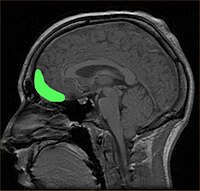
Photo from wikipedia
Threat-related information strongly biases attention, particularly for high anxious individuals. It is less clear though what the consequences of attentional capture by threat are and how this influences subsequent visual… Click to show full abstract
Threat-related information strongly biases attention, particularly for high anxious individuals. It is less clear though what the consequences of attentional capture by threat are and how this influences subsequent visual processing. This study examined how capture by threat influences visual search when attributes related to a threat reappear as task-irrelevant information. In Experiment 1, participants completed a search task preceded by task-irrelevant face cues on each trial expressing neutral, happy, or angry emotions. Faces were filtered to appear in different colors, where this color could match a nonemotional distractor object in the upcoming search display. Although the color of neutral/happy face cues had no impact on performance, there was evidence that angry face colors delayed reaction times when this color reappeared, driven by a positive correlation between costs and individual differences in trait anxiety. Experiment 2 assessed whether this phenomenon would be more readily observed when designating face cues task-relevant. When participants attended to and memorized faces for occasional probe trials, color biases were now evident irrespective of the emotional valence of face cues and unaffected by trait anxiety levels. These results suggest that task-irrelevant threat stimuli are granted privileged depth of processing by high anxious individuals, triggering biased attention toward features related to this object. Such biases are not dependent on threat per se, occurring for other objects voluntarily processed to similar depth regardless of personality factors. This highlights that anxiety-related phenomena, such as delayed disengagement of spatial attention from threat, may stem from task-irrelevant visual working memory representation. (PsycInfo Database Record (c) 2020 APA, all rights reserved).
Journal Title: Emotion
Year Published: 2020
Link to full text (if available)
Share on Social Media: Sign Up to like & get
recommendations!